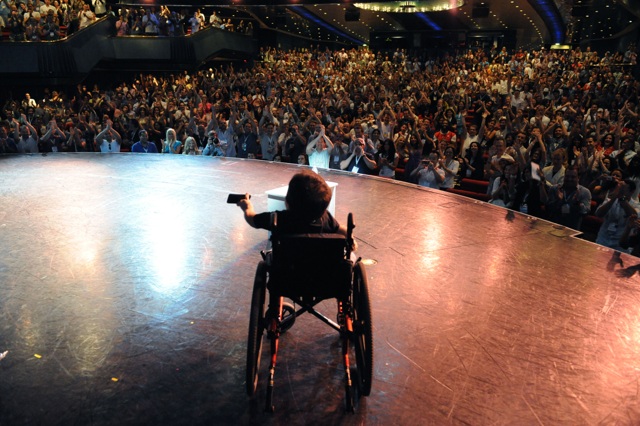Tech's young guard reaches for a new kind of summit

At around 7,000 feet above sea level, decreasing atmospheric pressure starts to affect the human body. Before acclimation, one might start to feel a bit lightheaded in this thin, rarefied air. Perhaps some of the 850 entrepreneurs, artists, programmers and scientists who attended Summit Outside felt that way last July, as they gathered in Eden, Utah, at a ski resort in the Wasatch Mountains.
Maybe it wasn't the altitude. Maybe it was the "intellectual discourse, creative experiences and altruistic components" that Thayer Walker, Summit's chief reconnaissance officer, says characterize these gatherings.
Summit is an event company that got its start in 2008when college dropout Elliott Bisnow convinced the founders of Vimeo and around 20 other young entrepreneurs to come skiing in Utah for a three-day trip on his dime. That bold move led to the Summit Series, increasingly bigger and more audacious experiences. By 2010, Bisnow and a crew of other 20-something upstarts hosted more than 700 of the country's movers and shakers in Washington, D.C., for inspiration and collaboration. Speakers included President Bill Clinton, Ted Turner and Russell Simmons and activities included yoga, whitewater kayaking and dancing. And fist pumping. Entry was no longer free.
The next year, 1,000 of these like-minded folks were invited to spend three days on a cruise ship headed for the Bahamas for a Summit at Sea. Last year Summit Series landed in Squaw Valley, Calif. Now, Summit has settled into a permanent home: a 10,000-acre, $40 million ski resort. Summit Outside was the inaugural Summit Series in the new digs, which the company wants to make an "epicenter of innovation, culture, and thought leadership." Investors in the property include Peter Thiel and Tim Ferriss.

Summit events have been called everything from "Camp David for Innovators" to "Silicon Valley tech conference-meets-nightclub in Miami." But Thayer bristles at the suggestion that Summit is all about the revelry. "If people want to party, they can go to a nightclub," he says. "People who come to our events, these are the busiest, most productive people in the world, who come here looking for a place where they get tremendous value that they can't find anywhere else. It's not transactional. It's about creating a human element. If you have a human connection, the transactional part is easy."
So, if the old model is that major business deals are sealed during opulent dinners in Michelin-rated restaurants or over 18 holes at Pebble Beach, does the new model replace fine dining with food trucks and replace golf with climbing crags? Are deals sealed around a DJ booth?
"I don’t think we created this trend," says Audrey Buchanan, a Summit partner and part of its curating team. "We tapped into a greater trend, internationally. There are lots of people who start businesses younger and run them in a more efficient way."
"I'm seeing this kind of approach more and more," notes Tonia Ries, a marketing, event and brand expert. "To a certain extent, I think people learn more when they're having fun. Is [Summit] just a playground? Well, how much did you learn when you were in the playground? You learn social skills, you learn how things work."
As for whether the Summit model will pay dividends in terms of stoking more innovation among a segment of the business world that is already known for its innovation, Ries says that depends on what attendees put into the opportunity.
"That's really not any different that asking: what is the ROI of attending Davos? It depends on whether you spend all your time skiing and hanging at the bar, or if you prepare and focus on goals and think about who you want to connection with," she says.
Thayer and Buchanan say Summit's success is already seen in the "tens of millions" of dollars that Summit attendees have raised for a list of non-profits since 2008. For Summit Outside, Buchanan added a landing page on the registration site that encouraged attendees to contribute to various non-profits local to Summit's new HQ. The 850 attendees raised more than $90,000 this way.
"You have younger people entering the business sector because technology has made business more accessible. Now, you see ideology woven into businesses that you've never seen before," says Walker, pointing to companies that use a "buy-one-give-one" model such as Warby Parker and TOMS shoes.
In fact, Warby Parker is one of the many companies in which Summit has invested. Others include the movie app Qwiki, which Yahoo acquired this summer for $50 million.
Elizabeth Gore, the United Nations Foundation's entrepreneur in residence, attributes Summit with offering "immeasurable help to the UN Foundation, generating more than 100 relationships that have benefited issues ranging from global health to human rights." She says Summit even helped her organization conceive of the Global Entrepreneurship Council, which is "becoming a model that governments and NGOs are adopting for the engagement of entrepreneurs.”
Will the Summit Series will become the model that governs meetings of the top young minds in tech and business? It certainly is breaking trail toward that peak.
NOTE: An earlier version of this article called Summit's new home a "former" ski area. In fact, it is still operable.
(Photos: Courtesy of Summit)
This post was originally published on Smartplanet.com
